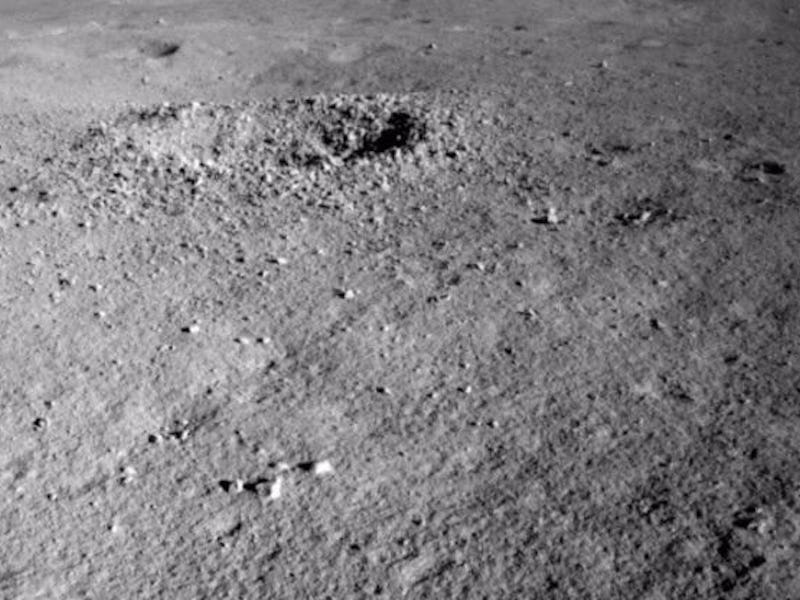Scientists finally figured out what that gel-like stuff is on the Moon
This was likely the result of a meteorite impact.

While roaming the far side of the Moon, China's Chang'e-4 lunar lander mission discovered an unusual, gel-like substance on the lunar surface. The discovery puzzled scientists, who poured over the images sent over by the Yutu-2 rover to try and figure out what this strange substance is.
A year later, and a team of scientists may have just solved this lunar mystery.
A new study, published in the August issue of Earth and Planetary Science Letters, revealed that the gel-like substance is, not very shockingly, rock. The reason why the rock glistened and appeared gel-like in the images captured by the Yutu-2 rover is that it was melted together possibly in the aftermath of a meteorite impact.
The Chinese lunar lander spotted a greenish, glistening substance on the far side of the Moon.
Yutu-2 landed on the Moon in January 2019 with a mission to explore the far side of the rocky body. The far side of the Moon is the side of the Moon that faces away from Earth, which makes it far and therefore far less explored.
The reason why it is so difficult to send anything, robot or man, to the far side of the Moon, is because it is difficult to maintain communications with ground control on Earth with a giant rock in between (the Moon!).
The initial discovery was made by the rover in July 2019, and announced in the Chinese science outreach blog, Our Space, later in August. Yutu-2 found what appeared to be a differently colored, slightly greenish material, shinning in the center of the Von Kármán in the South Pole basin of the Moon's far side. The substance measured at around 20 inches by 6 inches.
Although the images were released later, the Chinese publication described the substance as 'gel-like' which is quite odd for the dry, dusty surface of the Moon.
In order to determine what the substance is, the team of scientists behind the new study analyzed the images and compared it with samples brought back from the Moon by the Apollo mission.
They found that the discovered substance resembled samples from Apollo of a lunar impact melt. Therefore, the study suggests that the glistening, greenish substance is in fact rock that melted together likely after being heated from the violent impact of a meteorite that crashed into the Moon.
The researchers believe that as the meteorite hit the surface of the Moon, it melted some of the regolith, which then stuck with unmelted regolith.
The results of the study are in no way conclusive, but rather present the most plausible scenario and dismiss claims of unusual, gel substance on the far side of the Moon.
Chang’e 4 launched in December 2018. it is the fourth lunar mission by China’s space agency and the only one to land on the Moon's far side ever. The first two missions were orbiters, and the third was an orbiter-rover hybrid that landed on the near side of the Moon.
The rover landed in the Von Karman crater, located near the Moon’s south pole. This area is of particular interest to scientists, as it holds water ice, which may one day be used as a resource for long-duration, manned missions to the Moon.
Abstract: Chang'e-4 rover discovered a dark greenish and glistening impact melt breccia in a crater during its traverse on the floor of Von Kármán crater within the South Pole Aitken (SPA) basin on the lunar farside. The discovered breccia, being 52 × 16 cm, resembles the lunar impact melt breccia samples 15466 and 70019 that returned by the Apollo missions. It was formed by impact-generated welding, cementing and agglutinating of lunar regolith and breccia. Clods surrounds the breccia-hosting crater were crushed into regolith powders by the rover's wheels, indicating the regolith may be compacted slightly and becomes blocky and friable. Relative mineral fractions are estimated from the in situ measured spectra by a Hapke model-based unmixing algorithm. Unmixing reveals that plagioclase (PLG, 45 ± 6%) is dominant in the regolith, followed by almost equal fractions of pyroxene (PYX, 7 ± 1%) and olivine (OL, 6 ± 2%), indicating the regolith is likely related to noritic rocks. The regolith measured by Chang'e-4 rover was actually a highly mixture of multiple sources, with ejecta from Finsen crater being primary and possible contributions from Alder crater. Finsen and Alder craters are on the margin of the proposed impact melt pool produced by the SPA basin-forming event. Therefore, the ultimate source of the regolith might originate from a differentiated melt pool or from a suite of igneous rocks.